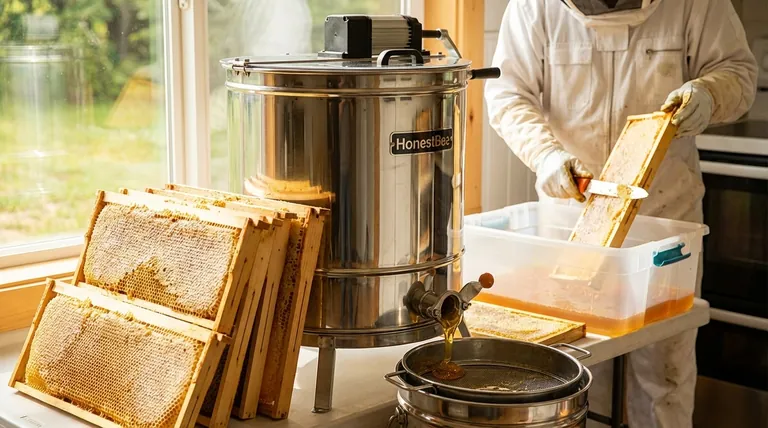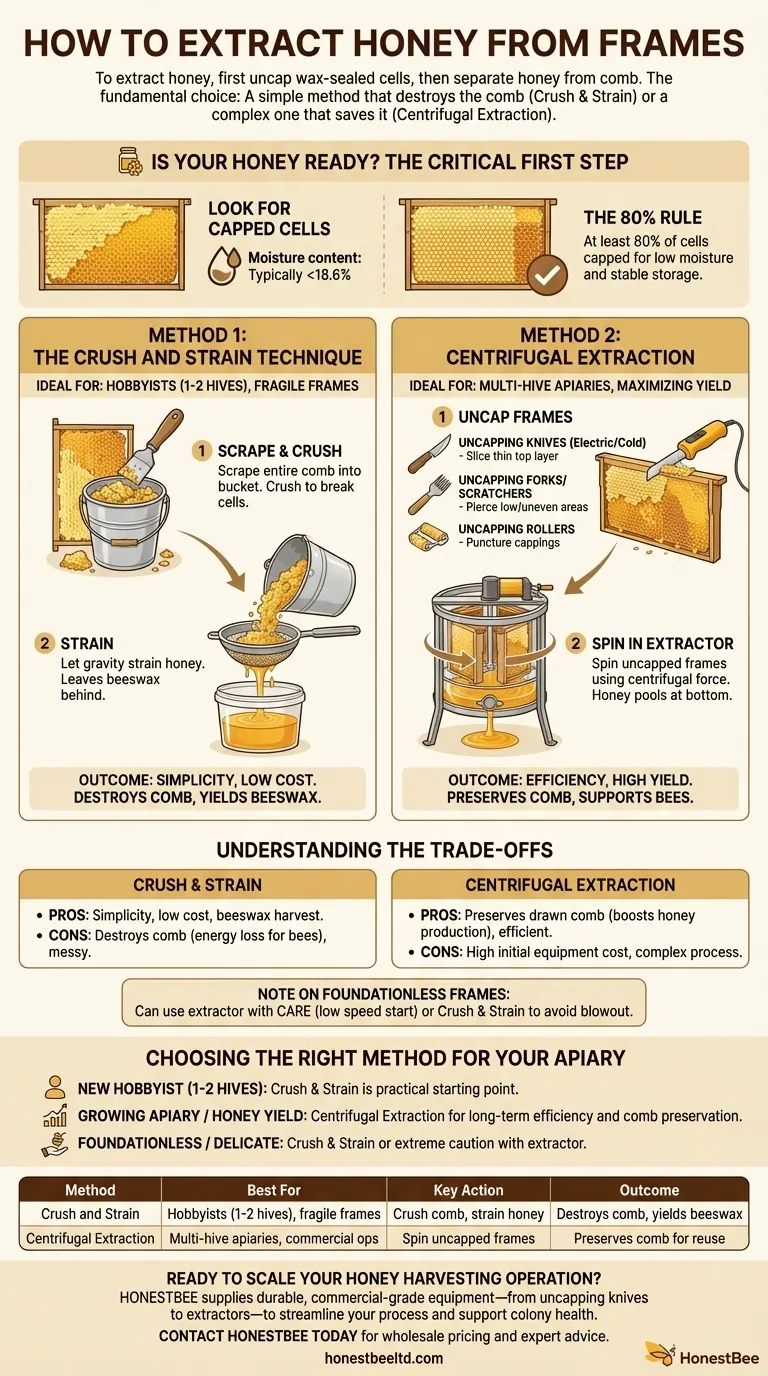To extract honey from frames, you must first uncap the wax-sealed honey cells and then use one of two primary methods to separate the honey from the comb. For small-scale operations, the "crush and strain" method involves scraping the entire comb into a bucket, crushing it, and letting the honey drain through a sieve. For larger harvests, beekeepers use a centrifugal extractor, which spins the uncapped frames to sling the honey out while preserving the delicate wax comb for the bees to reuse.
The fundamental choice in honey extraction is not just about the process, but about what you want to preserve. You must decide between a simple method that destroys the comb (Crush and Strain) and a more complex one that saves it (Centrifugal Extraction).

The Critical First Step: Is Your Honey Ready?
Before you bring any tools near your frames, you must verify the honey is "ripe." Extracting honey with too high a moisture content will lead to fermentation and spoilage.
Look for Capped Cells
Bees cap honey cells with a fresh, waxy coating when the honey has reached the correct moisture level (typically below 18.6%). A frame that is ready for harvest will be covered in this distinctive yellow-white wax.
The 80% Rule
As a general rule, a frame is considered ready for extraction when at least 80% of its cells are capped. This ensures the overall moisture content of the harvested honey will be low enough for stable, long-term storage.
Method 1: The Crush and Strain Technique
This method is the most straightforward and requires minimal specialized equipment, making it ideal for beginners.
Who It's For
The crush and strain technique is perfectly suited for hobby beekeepers with only one or two hives, or for those working with fragile, foundationless frames that might not survive an extractor.
The Process
The steps are simple and rely on gravity. You scrape the entire honeycomb from the frame into a large, food-grade bucket. You then crush the comb to break open all the cells and pour the entire mixture into a sieve or strainer placed over a clean container. The honey slowly drips through, often left overnight, leaving the beeswax behind.
Method 2: Centrifugal Extraction
This is the standard method for beekeepers who want to maximize efficiency and support their colony's productivity by preserving the comb.
Who It's For
This method is for beekeepers with multiple hives or anyone who wants to give their bees a head start on the next honey flow. By returning the intact "drawn" comb to the hive, you save the bees an immense amount of energy they would have spent rebuilding it.
Step 1: Uncapping the Frames
Before placing frames in an extractor, you must remove the wax cappings. This is done with specialized tools, each serving a slightly different purpose.
- Uncapping Knives (Electric or Cold): These are used to slice off the top layer of wax. The key is to use a gentle, sawing motion and go "skin deep" to remove only the cappings without cutting into the deeper comb structure.
- Uncapping Forks or Scratchers: These tools have sharp tines used to pierce and lift the cappings in low-lying or uneven areas of the comb that a knife might miss.
- Uncapping Rollers: A simple tool with sharp points that punctures the cappings to allow honey to escape.
Step 2: Using the Extractor
An extractor is a drum that holds the frames and spins them, using centrifugal force to sling the honey out of the cells and onto the inner wall of the tank. The honey then pools at the bottom, where it can be drained through a spigot.
Understanding the Trade-offs
Neither method is universally superior; the right choice depends entirely on your goals, scale, and equipment.
Crush and Strain: Pros and Cons
The primary advantage is its simplicity and low cost. The main disadvantage is that it destroys the beeswax comb. Bees must consume a significant amount of honey to produce wax, so giving them back empty comb is a huge energy-saver for the colony. On the other hand, this method provides a secondary harvest of clean beeswax.
Centrifugal Extraction: Pros and Cons
The key benefit is the preservation of the drawn comb, which significantly boosts a colony's potential honey production. The downsides are the high initial cost of the extractor and the additional complexity of the uncapping and extraction process.
A Note on Foundationless Frames
While you can use an extractor for foundationless frames, it requires great care. Ensure the comb is attached to all four sides of the frame. Start the extractor at a very low speed to allow some of the heavy honey to exit before ramping up, which reduces the risk of the fragile comb "blowing out" from the force.
Choosing the Right Method for Your Apiary
Filter your decision through your primary objective as a beekeeper.
- If you are a new hobbyist with only one or two hives: The Crush and Strain method is the most practical and cost-effective starting point.
- If you plan to grow your apiary or prioritize honey yield: Investing in an extractor to preserve the drawn comb is the most efficient long-term strategy.
- If you are working with foundationless or delicate frames: Use the Crush and Strain method or exercise extreme caution with an extractor, starting slowly to prevent comb damage.
Understanding these methods empowers you to harvest your honey efficiently while supporting the long-term health and productivity of your hives.
Summary Table:
| Method | Best For | Key Action | Outcome |
|---|---|---|---|
| Crush and Strain | Hobbyists (1-2 hives), fragile frames | Crush comb, strain honey | Destroys comb, yields beeswax |
| Centrifugal Extraction | Multi-hive apiaries, commercial operations | Spin uncapped frames in an extractor | Preserves comb for bees to reuse |
Ready to Scale Your Honey Harvesting Operation?
For commercial apiaries and beekeeping equipment distributors, choosing the right extraction method is key to maximizing efficiency and honey yield. HONESTBEE supplies the durable, high-capacity equipment you need—from uncapping knives to commercial-grade centrifugal extractors—to streamline your process and support your colony's health.
Contact HONESTBEE today for wholesale pricing on professional beekeeping supplies and expert advice tailored to your operation's scale.
Visual Guide

Related Products
- Electric 8 Frame Honey Spinner Extractor Equipment for Beekeeping
- HONESTBEE 72 Frame Industrial Electric Honey Extractor for Beekeeping
- 2 Frame Stainless Steel Manual Honey Spinner Extractor for Beekeeping
- HONESTBEE 3-Frame Manual Acrylic Honey Extractor
- 8-Frame Electric Self-Reversing Honey Extractor Spinner for Commercial Honey Extraction Equipment
People Also Ask
- What equipment is needed for extracting honey? A Complete Guide for Every Beekeeper
- What are the differences between manual and electric honey extractors? A Beekeeper's Guide to Power, Speed & Cost
- How long should you spin honey? Master the Art of Efficient, Damage-Free Extraction
- What are the best storage conditions for a honey extractor? Protect Your Investment for Next Season
- What machines are needed in beekeeping besides basic tools? Scale Your Honey Harvest Efficiently



















